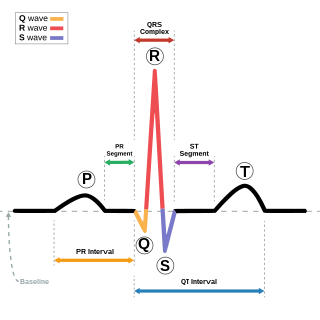PR interval
Period in electrocardiography From Wikipedia, the free encyclopedia
In electrocardiography, the PR interval is the period, measured in milliseconds, that extends from the beginning of the P wave (the onset of atrial depolarization) until the beginning of the QRS complex (the onset of ventricular depolarization); it is normally between 120 and 200 ms in duration. The PR interval is sometimes termed the PQ interval.

Interpretation
Variations in the PQ interval can be associated with certain medical conditions:
- Duration
- A long PR interval (of over 200 ms) indicates a slowing of conduction between the atria and ventricles, usually due to slow conduction through the atrioventricular node (AV node).[1] This is known as first degree heart block.[1] Prolongation can be associated with fibrosis of the AV node, high vagal tone, medications that slow the AV node such as beta-blockers, hypokalemia, acute rheumatic fever, or carditis associated with Lyme disease.[2][3]
- A short PR interval (of less than 120ms) may be associated with a Pre-excitation syndromes such as Wolff–Parkinson–White syndrome or Lown–Ganong–Levine syndrome, and also junctional arrhythmia like atrioventricular reentrant tachycardia or junctional rhythm.
- A variable PR interval may indicate other types of heart block.[citation needed]
- PR segment depression may indicate atrial injury[4] or pericarditis.[5]

See also
References
Wikiwand - on
Seamless Wikipedia browsing. On steroids.
